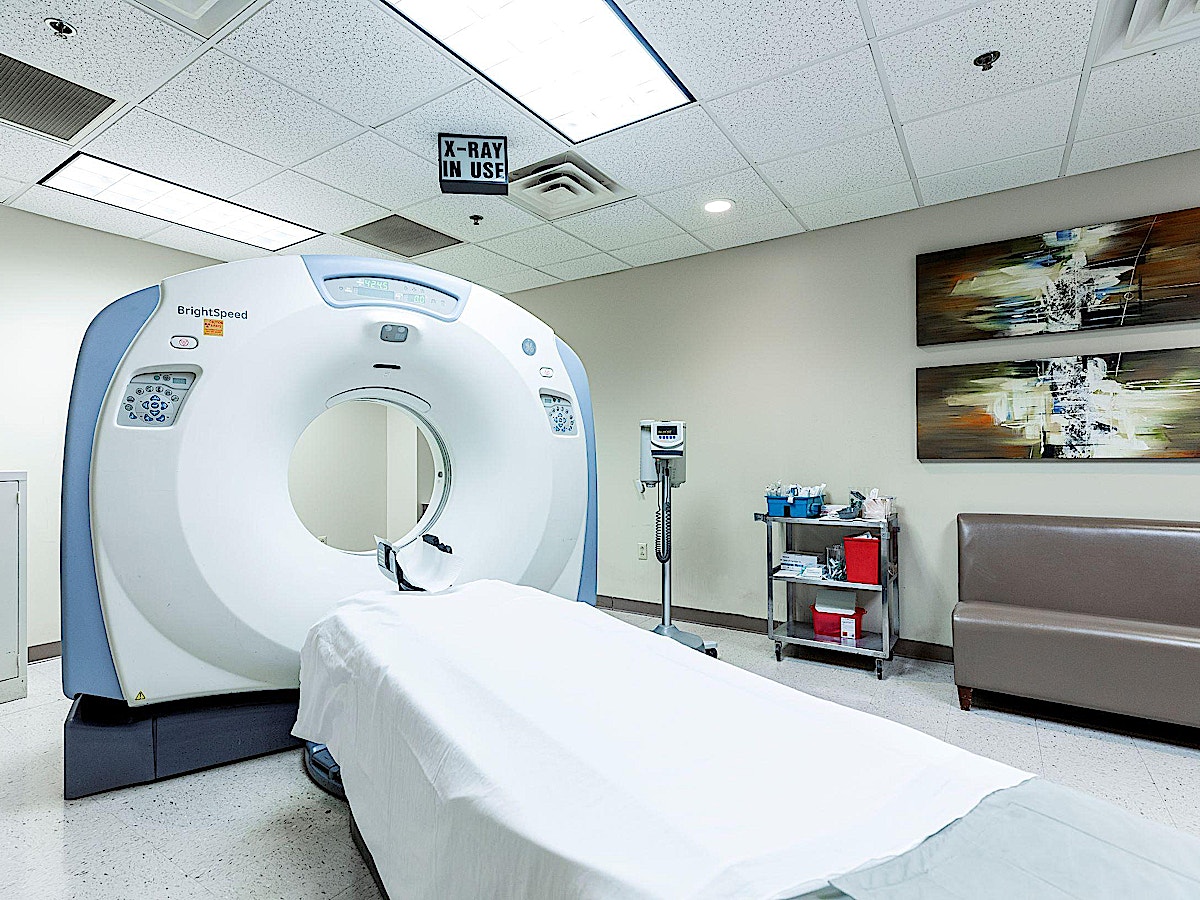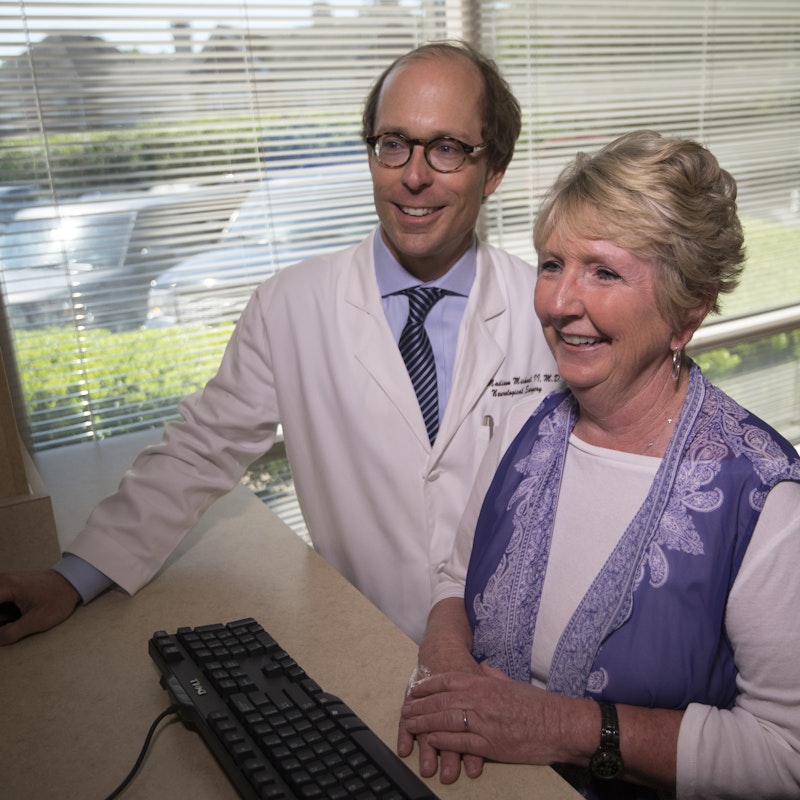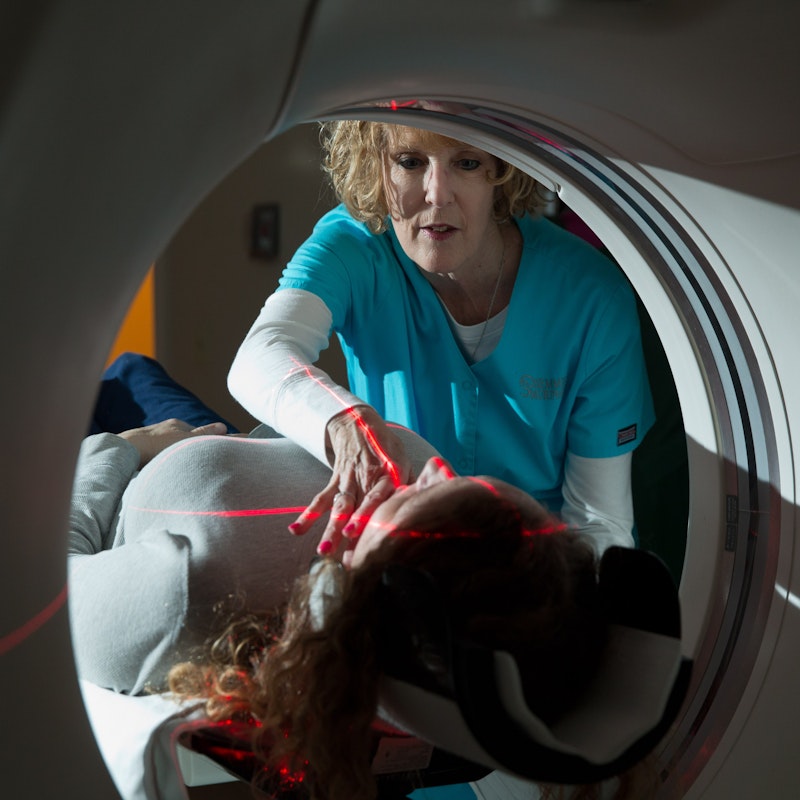Computerized Tomography (CAT Scan or CT)

A computerized tomography scan (CT or CAT scan) is a noninvasive, diagnostic imaging procedure very similar to an X-ray in that the machine uses X-rays to create three-dimensional (3D) images of a section of the body. CT images provide more detailed information than X-rays.
Basically, this procedure captures and combines a series of X-ray images taken from different angles around your body to create cross-sectional photographs of the bones, blood vessels and soft tissues inside a specific area or “slice” of your body.
The information is sent to a computer that interprets the data and displays it in a two-dimensional (2D) form on a monitor.
Why do I need this test?
The Semmes Murphey clinicians use CT scans to visualize nearly all parts of the body to diagnose diseases or injuries as well as plan appropriate treatments, surguries or radiation plans.
CT scans are particularly good at viewing veins and arteries especially when a contrast medium is injected into the body to help identify veins and arteries as well as the spine and bones.
Are there any risks?
In general, X-rays (which are used in CT scans) are very safe and unlikely to produce side effects.
X-ray technology has been in use since its discovery and development in 1895. Today this technology is both safe and effective. The benefits from these tests far outweigh the risks.
Even though patients are exposed to a slightly greater amount of radiation during a CT scan than they would during a plain X-ray, CT scans have not been shown to cause long-term harm. However, there may be a small increase in your potential risk of cancer.
Please alert your health care provider if you:
- Have a history of radiation exposure, like previous scans and other types of X-rays, or if you have had a recent procedure using a contrast medium as any residue may interfere with obtaining optimal exposure.
- Are or think you may be pregnant (Many physicians will request a negative pregnancy test before administering an X-ray exam.)
- Have ever had a reaction to any contrast dye
- Have any kidney problems
- Are diabetic
There may be other risks depending on your specific medical issues. Make sure your healthcare provider knows about all your medical problems, history and current medications before the procedure.
Young children and developing fetuses are more sensitive to X-rays and are at higher risk for tissue damage. Radiation exposure during pregnancy may lead to birth defects. If it is necessary for a child or pregnant woman to have an X-ray, special precautions will be made to minimize the radiation exposure to them.
What should I do to prepare?
The most important thing you can do to prepare for your test is to alert your physician if you:
- Are pregnant or might be pregnant
- Are diabetic or have an insulin pump
- Have had any kidney disease or surgery
- Have recently received any “contrast materials” during any other tests
- Have had any allergic reactions to medications or materials
Please discuss your medications with your physician to receive specific pre- and post-procedure instructions.
Your doctor may have general instructions, for example, to not eat or drink for a few hours before your scan, or specific instructions related to any of the above topics. But in most cases, there is very little you need to do to prepare for your test.
Diabetics may be instructed to eat a light breakfast or lunch three hours prior to the scan time. Depending on your oral medication for diabetes, you may be asked to discontinue the use of that medication for a specific time.
If your doctor ordered a CT scan without contrast, you can eat, drink and take your prescribed medications prior to your exam.
If your doctor ordered a CT scan with contrast, do not eat anything three hours prior to your CT scan. Contrast material is a special dye that can help highlight areas of the body being examined, like blood vessels, intestines or other structures.
If your child, infant or toddler is having a CT scan, the doctor may recommend a sedative to keep your child calm and still. Movement blurs the images and may lead to inaccurate results. Ask your doctor how to prepare your child.
The physicians at Semmes Murphey Clinic have a world-renown reputation in pediatric surgery and treatment based on their many years’ experience treating patients at both LeBonheur Children’s Hospital and St. Jude Children’s Research Hospital. Your doctor will help you prepare your child for this test and any phase of their treatment.
What should I expect during the test?
A radiology technologist, specifically trained and dedicated to administering these procedures, will perform the test.
You will be asked to remove all jewelry and change into a hospital gown. The CT scan room may be cool, because air conditioning is used to keep the equipment at a constant temperature.
The test itself is painless and relatively quick—approximately 30 minutes. You will not feel the radiation passing through your body.
Your physician may request that you receive a contrast material prior to the scan to give a better view of the area that is being tested. The contrast material will be administered either by injection, swallowing or insertion.
Upon receiving the contrast media, you may experience a flushing sensation, a salty or metallic taste in the mouth, a brief headache, or nausea and/or vomiting. These effects usually last for a few moments. Alert the technician of any reactions immediately.
You will then be asked to lie on a narrow, motorized table which will move you into a large, round opening into the CT scanner. It is very important that you remain still during the test. Pillows and straps may be used to prevent movement and help you stay in position and minimize any discomfort or pain.
The technologist will be in an adjacent room where the scanner controls are located. However, the technologist will be watching you at all times and will be in constant communication via speakers and microphones inside the scanner.
During the procedure you may hear buzzing, whirring or clicking sounds, which are normal.
When the procedure has been completed, you will be removed from the scanner. If an IV line was inserted for contrast administration, the line will be removed.
You may be asked to wait a few minutes while the technologist makes sure the images are acceptable and not blurred, and to monitor you for any reactions or side effects to the contrast media.
If you notice any pain, redness, and/or swelling at the IV site after you return home following your procedure, you should notify your physician as this could indicate an infection or other type of reaction.
Otherwise, there is no special type of care required after a CT scan of the spine. You may resume your usual diet and activities unless your physician advises you differently.
Your physician may give you additional or alternate instructions after the procedure, depending upon your situation.
If your child is having a CT scan, restraints or other techniques may be used to keep them still. These won't harm your child. They will help prevent your child from moving and the need for a repeat procedure.
You may be allowed to stay with your child during the test. If you do, you'll likely be asked to wear a lead apron to shield you from unnecessary exposure.
When will I receive my results?
A radiologist (a doctor who specializes in evaluating these test results and other radiology procedures) will interpret the scans and report the test results to your doctor.
If your appointment is the same day as your test, your physician may review them with you at that time. Otherwise, most test results are reviewed with you at your next scheduled appointment.
This information was provided by the specialists at Semmes Murphey Clinic. Readers are encouraged to research trustworthy organizations for information. Please talk with your physician for websites and sources that will enhance your knowledge and understanding of this issue and its treatments.



Experience the Semmes Murphey Difference for yourself.
Request an Appointment